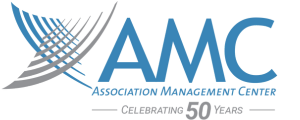
It's the Thought That Counts! Productivity Series Part 3
In the second part of this productivity series, I shared tips from AMC’s Caffeine and Productivity SIG for physical activities that can help you focus at work. From stepping away from your desk for lunch or a walk to protecting your sleep time and desk stretches, there are many ways you can trick your body into being productive.
In the final segment of my three-part series, after previously discussing how you can use technological and physical productivity tools, I will leave you with some mental productivity methods to think about. With the following 5 thought activities (and the previous blog installments), you will now have technological, physical, and mental tools to keep you at the top of your productivity game.
Top 5 Thought Activities to Keep You Focused at Work
Set SMART goals.
We touched on this idea in the last blog post with the idea of tracking your progress, but I wanted to expand on that, as tracking your progress is not the same as setting expectations for yourself. Setting attainable goals will help you feel motivated while working towards them and then accomplished when achieving them. Aim for setting SMART goals, which are specific, measurable, achievable, relevant and time-bound, allowing for attainable, thoughtful actions you can take to meet expectations for yourself and your role.
I suggest avoiding a VAPID (vague, amorphous, pie-in-the-sky, irrelevant, delayed) goal. Created by author Randy J. Paterson, PhD, these goals are usually unclear and can be completely unattainable, have little value to you or your role, and have no time frame.
Avoid procrastination.
This might be easier said than done, and I am guilty of procrastinating as well. One way to avoid procrastination is by setting deadlines and breaking down tasks in a way that answers questions, such as
- Who should you contact?
- What materials are needed to complete this task?
- What is the deadline?
The more specific questions you can ask and answer about your goals for the task, the better. This also allows you to get over the hump of delaying a project because you are having trouble knowing where to start. Another way to avoid procrastination and create momentum is to begin a project at whichever phase you find the most interesting. It’s not always necessary to start at the beginning.
Change your thinking.
Don’t dwell on the negative when a project isn’t progressing as you would like. When projects aren’t going well you may have a tendency to continue to expect that negative results will occur based on previous experiences. One way to avoid negative thinking is through cognitive restructuring, a psychotherapeutic process of learning to identify irrational or maladaptive thoughts known as cognitive distortions (e.g., all-or-nothing thinking, over-generalization, and emotional reasoning).
Mindtools.com suggests the best way to apply this thinking is to reframe your thoughts by calming yourself, identifying the situation, analyzing your mood, and identifying automatic thoughts. After you complete those steps, you force yourself to reframe your thinking.
An example of reframing would be having an immediate reaction of, “This will never work,” applying the aforementioned steps to reach a thought conclusion of “We haven’t tried XYZ yet, maybe that will help fix this problem.” Another example would be, “I can’t believe she missed this deadline again,” to “I know she had unscheduled PTO 3 times last week, so I will check to see if she’s OK and has a solution for how we can finalize this project.”
Meditate for 5 minutes.
Meditation sometimes has a connotation of being ineffective or silly, but it really is what you make of it. Meditation can be as simple as listening to your breath, finding a comfortable seat, and turning off all electronic devices. It can also involve a personal “mantra” or phrase of what you want your day to look like, such as “I will have a calm day” and thinking about what that means while breathing in and out. We have talked about breathing exercises during a “Stress and Productivity” lecture in our Caffeine and Productivity meeting here at AMC, and I wanted to share a few here:
Sama Vritti: “Equal Breaths”
- Through the nose, inhale for a count of four and exhale for a count of four.
The beauty of “equal breaths” is that it’s an incredibly discreet exercise, making it perfect for tense moments in front of others, such as during conflict with colleagues or when a surprise project has just been mentioned during a meeting.
Abdominal Breathing
- Place one hand on your chest and the other on your belly.
- Inhale deeply through your nose, ensuring the diaphragm (not the chest) inflates.
- Shoot for six to 10 deep breaths per minute for 10 minutes.
With abdominal breathing, you know your diaphragm is opening up when your entire belly moves. People often don’t breathe this way, so if you’re struggling to inhale deeply enough, I suggest practicing at home. Lay down in a comfortable position so your breathing naturally will be slower and deeper, and keep a hand on your belly to ensure that it’s moving. Please note: you’re likely to feel a bit of a head rush practicing these kinds of breathing exercises, but if you feel dizzy or uncomfortable, adjust the counts to what makes you feel most comfortable.
Focus on your “why.”
At the start of each day, ask yourself what you like about your work for the day. What do you want to learn for the day? What are you looking forward to? Steve Farber, president of the San Diego-based leadership coaching firm Extreme Leadership, suggests, “If you see your work as meaningful, you’ll work harder and be more productive as a result. At the start of the day, ask yourself what value you create for your colleagues or customers. Answering this question for yourself will have an immediate, positive effect on your mindset and personal energy.” If it helps, you can write your answers down each morning and reference them throughout the day.
In conclusion
And with that, this blog series ends, but I hope your learning and productivity continues! I challenge you to use some of these resources in your daily routine, and if you’ve found this installment helpful, I challenge you to share it with your team!
Heather Payette is a Content Marketing Associate and serves as the co-chair of AMC’s Caffeine and Productivity SIG
Be the first to know about the latest articles, news, and events from AMC. Sign up for our emails!


